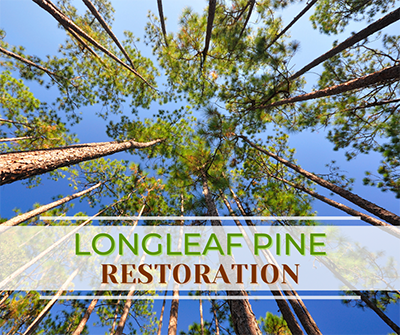March 16, 2021 - Texas A&M Forest Service and the Texas Longleaf Pine Implementation Team have announced available funding for private landowners interested in restoring and enhancing longleaf pine ecosystems on their property. Grants have been made available by the National Fish and Wildlife Foundation (NFWF) and International Paper (NYSE: IP) through the Forestland Stewards Initiative. Funding was granted to help conserve and restore this iconic and important American landscape.
Longleaf pine ecosystems are a natural part of East Texas, and once spanned over 92 million acres across the American south. By the early 2000s, that number had fallen to 3.2 million acres. Thanks to longleaf pine restoration programs, that number has begun to rise again – today it’s up to 4.7 million acres – but it is still just 5% of their original volume.

Beyond their ties to Texas heritage, longleaf pine ecosystems also provide a critical habitat for the most diverse plant and wildlife ecosystems on the continent. More than 40 plant species have been identified within a single square meter of longleaf pine forests, with up to 140 different species per quarter-acre, all inside of a prairie-style understory that houses few shrubs or woody plants. This environment is ideal for game species – such as white-tailed deer, wild turkey and quail – as well as more endangered species, like the pocket gopher, Louisiana pine snake, Bachman’s sparrow and the red-cockaded woodpecker.
“The contributions made by IP and NFWF through the Forestland Stewards Initiative will go a long way to restoring one of the most critical and diverse forest ecosystems within the state of Texas,” said Hughes Simpson, Forest Systems Department Head at Texas A&M Forest Service.
Populations of longleaf pine began dwindling in the 20th century, when timber harvesting was at its peak in East Texas. Longleaf pine was harvested for its high quality fiber, huge diameter and tall, straight boles, which in turn produced high quality lumber. Texas A&M Forest Service, along with the Forestland Stewards Initiative and the Texas Longleaf Implementation Team, hope these qualities also produce an economic incentive for landowners to plant and sustainably harvest longleaf pine.
“The forest sector contributes $41 billion to the Texas economy annually,” said Simpson. “This project will add to that contribution, while providing critical habitat to endangered plant and animal species in Texas, clean drinking water and carbon storage.”
Available funding can assist landowners with the cost of site-preparation and tree planting, as well as longleaf maintenance practices like prescribed burning and other activities that promote forest stand improvement.
Landowners interested in planting or restoring longleaf pine on their property can apply for financial assistance with THIS FORM. Texas A&M Forest Service is also accepting applications from landowners looking to enhance already established stands of longleaf pine.
For more information about longleaf pine initiatives and how to apply for financial assistance, visit: http://tfsweb.tamu.edu/longleaf
The deadline for applications is April 15th, 2021. All applications should be emailed to TexasLongleafTeam@gmail.com. Hard copies can be mailed to the following address:
Texas A&M Forest Service
Forest Systems Department
200 Technology Way #1281
College Station, TX 77845
Contacts:
Hughes Simpson, Forest Systems Department Head, Texas A&M Forest Service, hsimpson@tfs.tamu.edu, (979) 458-6658
Jenny Sanders, Texas Longleaf Implementation Team Coordinator, TexasLongleafTeam@gmail.com, 936-225-2175
Texas A&M Forest Service Communications Office, newsmedia@tfs.tamu.edu, 979-458-6606








